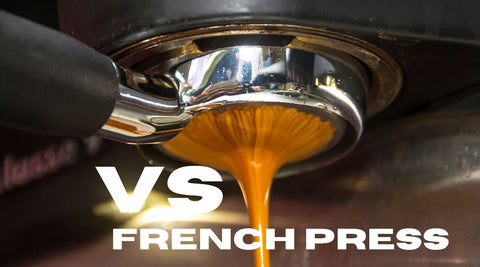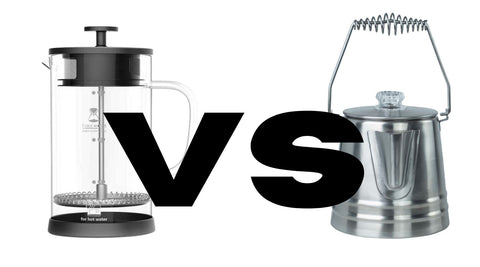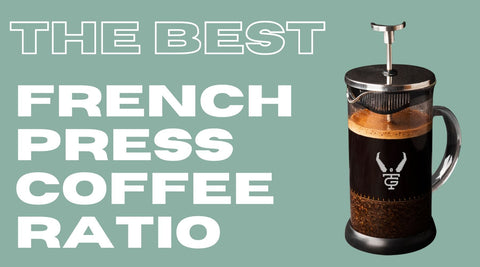Coffee lovers everywhere can appreciate the delicious flavors that each of the different brewing methods brings to the table, and it's no surprise that when it comes to French press vs espresso are two of the most iconic and beloved versions of great coffee. In this article, we'll dive into an in-depth analysis of the differences between these two methods, starting with their history and ending with a contrast of the resulting brews.
We'll also look into the time required to make each type and the impacts of choosing one over the other.
No matter if you're a coffee connoisseur who likes to grind your own beans or a newbie at making coffee at home, this article will leave you appropriately equipped to make your own informed choice about which to choose: A good cup of Espresso or French Press?
Espresso Vs French Press: Which Is Better?
Two iconic coffee brewing methods - French Press and Espresso - discussing the differences in taste, equipment needed, and health benefits/concerns. It recommends medium to dark roast beans with a coarse grind for French press coffee making and medium-dark to dark roast Arabica beans ground finely are best for Espresso. How much coffee you need for each method will also be covered.
What is Espresso Coffee?

Espresso is a highly concentrated form of coffee made by forcing boiled water through the fine ground coffee at high pressure. Unlike other brewing techniques, such as drip coffee, espresso requires finely ground, almost powder-like coffee and a specialized machine to create the desired flavor and texture (and in only a few seconds).
The espresso machine is designed to push hot water through the ground coffee at extremely high pressure, usually between 9 and 15 bars. This high pressure extracts more flavor from the coffee beans and creates a more concentrated cup with a bold flavor and strong coffee aroma.
In addition to the espresso machine, espresso requires a special roast of coffee beans. Darker roast espresso beans (great for making cold brew) are typically used because they have a higher oil content and fuller flavor than the lighter roast, and this is what makes espresso so unique.
Espresso beans, when compared to regular coffee beans used for drip coffee, have more of a fine grinds texture. The fine grind of espresso beans allows for the hot water to be pushed through quickly and efficiently, creating a thick and creamy crema on top. Because espresso produces crema as its final layer is one of the reasons why it is so popular, and considered a rich coffee in Europe.
The result of the espresso process is a thick, concentrated coffee that packs a punch of flavor and caffeine. It is commonly served in a small cup, known as a demitasse, and acts as the foundation for many coffee drinks, such as lattes and Frappuccino's. Espresso makes for a great sweet treat ingredient and is also often used as an ingredient in desserts, such as tiramisu and affogato.
And if it has been a late night, the caffeine content in a double shot could certainly help get the wheels turning and keep you going throughout the day. Do, however, keep track of how much caffeine you have during the day, a double shot contains 60-100mg per serving and is enough for most people.
Espresso is an individual and flavorful coffee that is enjoyed by many coffee lovers globally. It is a classic coffee brewing method that produces a bold and intense cup of caffeine that is sure to kick-start your day or give you a much-needed afternoon pick-me-up.
What is French Press Coffee?

French pressed coffee is a brewing method that allows lighter roasts grounds to be in direct contact with water, resulting in a full-flavored and rich-tasting coffee. It requires a coarse grind and a specific coffee-to-water ratio. The French press is a container with a plunger, created by Attilio Calimani in 1929 in Milan.
The container is typically made of glass, which is placed in contact with a filter at the bottom. This filter is held in place by a metal or plastic frame. The plunger has a mesh filter that captures the grounds while allowing the coffee to pass through.
The coffee grounds are mixed with hot water and steeped for several minutes. After a few minutes, the plunger is pressed down, pushing the grounds to the bottom of the container and trapping the coffee in the vessel.
The French press process requires a specific grind size, as well as a specific temperature and steeping time. The temperature and steeping time will affect the flavor of the coffee, as a veteran coffee lover will undoubtedly be well aware of, but if not it is important to pay attention to these details.
The French press is a great way to enjoy a cup of coffee with a unique flavor and aroma, and it is also a great way to explore different coffee beans. Compared to other classic coffee brewing methods, like espresso, the French press does not produce crema. It is an inexpensive way to make coffee that is both simple and flavorful, and a less subtle option when you don't need more caffeine but are looking for that great coffee flavor.
Brewing Methods: French Press vs Espresso

In this section, we will be discussing the brewing processes of French Press and Espresso, two iconic coffees each with a bespoke brew method. French press and espresso are two of the most popular ways to make coffee and each produces a different type of coffee.
French press is a steeping method that uses hot water and coffee grounds to extract flavor from the beans. Espresso is a fast, high-pressurized brewing method that uses hot steam and water to extract flavor from the beans. Each method has its own unique flavors and bouquet, so it is important to understand the differences between them.
The French press method is one of the more traditional methods of brewing coffee. It involves adding coarsely ground coffee beans to a French press, adding hot water, and then pressing down the plunger. This slow immersion method allows for gentle release of flavors and caffeine. It is simple to use and can make multiple cups of coffee at once. The flavor of French-pressed coffee is full-bodied with bold and intricate notes.
Espresso is a high-pressurized brewing method that requires an espresso machine. The espresso machine uses very hot water to make the coffee. The beans are ground finely before use. This process extracts a concentrated shot of coffee with a delicate sweet flavor and a thick layer of crema. Espresso is usually served in small batches, making it a great choice for those looking for a strong, robust cup of coffee.
We have explored two well-known coffee brewing methods; French Press and Espresso. It has been a great discussion about their different brewing methods. French press is a more traditional, manual method that produces a full-bodied and bold cup of delicious coffee.
On the other hand, espresso is a high-pressurized brewing method that produces a concentrated shot of coffee with a delicate sweet flavor and a thick layer of crema. Both methods offer a unique essence, so it is essential to understand the differences between them to choose the right brewing method for your taste.
How to make French Press Coffee
To make French press coffee, one must use a manual immersion process that steeps coarsely-ground coffee beans for several minutes. The grind size for the French press is important to ensure that the coffee does not become too bitter or too weak. A medium to coarse grind should be used for the French press, ensuring that the grounds are not too finely ground.
French-pressed coffee is easy. The process is straightforward. Start by adding the coffee grounds to the French press and adding a bit of boiled water for blooming. Then, add the rest of the water and the plunger. Let the coffee steep for four minutes before slowly pressing down the plunger. This will create a rich, flavorful brew.
Another great aspect of French press coffee is that it can make multiple cups of coffee at once. This makes it a great option for social functions or for those who want to save time by making a few cups of coffee at once.
French-pressed coffee is a great choice for those looking for a bold, delicious mug of coffee with all the natural sugars, oils, and flavors of the beans. It is a manual process that requires no paper filter, allowing for all of the grounds to mix around in the water and steep. It is also a fast and easy way to make coffee with fewer steps than other brewing methods.
Making Espresso
Espresso is a fast, high-pressurized brewing method that uses hot steam and water to extract flavor from the beans. This method of brewing coffee requires an espresso machine and fine and smooth ground coffee beans. An espresso machine uses pressure to quickly force hot water through the coffee grounds, resulting in a concentrated shot of coffee that is darker in color and has a thicker consistency.
The espresso brewing process is complex and requires an espresso machine, but the results are worth it for a delicious, flavorful cup of coffee. Espresso machines use a pressurized system to force hot water through the coffee grounds, resulting in a concentrated shot of coffee with more caffeine than other brewing methods.
Espresso also has a unique flavor profile. It produces a shot of coffee that is both smooth and decadent with a slightly sweet flavor and a thick layer of crema. The crema is a thin layer of foam that forms on top of the espresso shot and it is one of the signature characteristics of espresso.
The espresso brewing process is complex and requires an espresso machine, but the results are worth it for a delicious, flavorful mug of coffee. Whether you're looking for a strong, concentrated cuppa or a light, gentle cup of coffee, both French press and espresso offer unique flavor profiles with their own set of benefits.
Beans: Roast and Grind for French Press vs Espresso

When it comes to coffee brewing, the type of beans and grind you use can make a big change in the taste of your daily, must-have coffee. For the French press, it is best to use fresh, coarsely ground coffee beans with a medium to dark roast profile and low acidity. The roast and grind size also affects the amount of caffeine in the coffee.
Espresso is made with very finely ground coffee beans, usually with a dark roast. This results in a more concentrated brew with more caffeine than French press coffee. The bean variety and grind size will make a huge difference in the flavor and body of your cup of java, so it's important to choose the right beans and grind for the brewing method you are using.
Ideal Beans and Grind for French Press
Regarding French Press coffee, the best beans and grind are medium to dark roast, and the grind should be coarse to avoid over-extraction. Darker roast beans are optimal for French press as they provide a fuller, bolder flavor with hints of sweetness and a robust body.
When grinding your beans, make sure to use a coarser grind than you would use for espresso. This will help to prevent over-extraction and bitter, muddy flavors. A coarse grind also ensures that you don't get small particles of coffee in your cup.
Therefore, when making French Press coffee, it is important to choose the right roast and grind of beans to get the most out of your cup.
Ideal Beans and Grind for Espresso
For espresso, it's best to use medium-dark to dark roast Arabica beans, ground very finely. It is important to use a fine grind as it provides resistance to hot, pressurized water for optimal flavor extraction. The finer the grind, the more challenging it is for the water to pass through the coffee grounds, making it easier to achieve a full-flavored cup of espresso with a more concentrated flavor.
Arabica beans are preferred for espresso as they provide rich, sweet, floral flavors. Robusta beans can also be used, however, they are easier to produce crema. Darker roast beans are best for espresso as they provide a full-bodied, concentrated flavor.
Accordingly, when making espresso, it is a necessity to choose the right roast and grind of beans to get the most out of your cup.
Taste Profile of French Press vs Espresso

The taste profiles of espresso and French press coffee are quite different, and the factors that influence the flavor of each type of coffee are varied. Unlike regular coffee, espresso is an intense, concentrated form of coffee that is created when hot water is forced through finely-ground coffee beans. This process produces a bold, robust flavor with many notes of sweetness and a thick crema on top.
French press coffee, on the other hand, is made by steeping coarsely ground coffee in hot water. This produces a milder, smoother cup of coffee with less acidity and a more subtle aroma. The beans used to make French press coffee are typically roasted a bit darker than those used for espresso, which can add an earthy, smoky flavor to the cup.
Plus, the grind size of the coffee beans is also important when it comes to the flavor of the coffee. For espresso, finer grounds are used to extract all of the flavors from the beans. For the French press, coarser grounds are used, which allows for a more mild and less acidic cup.
The amount of caffeine in a cup of espresso is higher than in a cup of French press coffee because espresso is made with more concentrated coffee grounds and is brewed with hot water for a shorter cycle. This means that espresso produces a stronger and more caffeine-rich cup of brew. If you’re looking for a more energizing cup of coffee, espresso is the way to go.
Equipment Needed: French Press vs Espresso

Pertaining to making coffee, the equipment used can have a big shock on the taste of the end product. Both the French press and espresso are classic coffee brewing methods that have been around for centuries. But each method requires different equipment to achieve the best results. The French press and espresso both produce a great cup of coffee, but the equipment needed for each brewing method can vary significantly.
When it comes to French press vs espresso, the right equipment is essential for achieving the perfect cup of morning coffee. Investing in top-tier equipment will certify that the final product is of the highest quality. From coffee grinders and French presses to espresso machines and milk-frothing pitchers, it is important to understand what each type of equipment is used for and how to use it properly.
French press vs espresso
French press equipment
To make French press coffee, you need hot water, ground coffee, and a French press. No fancy equipment is required, but a scale, a grinder, and a gooseneck kettle can be helpful. A French press is a simple and affordable device that is used to steep coffee grounds in hot water and then press them down after steeping. The case of a French press is usually made from glass, plastic, stainless steel, or stoneware. French presses come in a variety of sizes and can range from $15-30.
To make the best French press coffee, the coffee grounds must be the right size. A medium-coarse grind is ideal for French press coffee, as this allows the coffee grounds to be steeped in the water for the optimal amount of time. A burr coffee bean grinder is the best option for achieving the right grind size. A burr grinder uses two plates to grind the beans evenly and consistently, which ensures that all of the coffee grounds are the same size.
Making French press coffee, the water temperature is also important. It should be just off boiling and ideally should not exceed 200 degrees Fahrenheit. A thermostat can be used to establish that the water is at the correct temperature. A gooseneck kettle is a helpful tool for achieving precise water temperature. The gooseneck spout helps to control the flow of water, allowing for greater accuracy when pouring.
When it comes to French press coffee, the equipment needed is minimal and the cost is relatively low. The process of making French press coffee is straightforward, and the resulting cup of coffee is rich and flavorful.
Espresso equipment
For making espresso, you need an espresso machine, a coffee grinder, a tamper, a filter, and a milk frothing pitcher. An espresso machine is an electric appliance that uses hot water under pressure to extract the flavor and aroma of coffee beans. There are several different types of espresso machines, including those with built-in grinders, detachable filter cups, and space for coffee pods.
When using an espresso machine, the number of coffee grounds and their grind size are important. Espresso machines require a finer grind than French press coffee. The grind should be fine enough to ensure that the brewed coffee is strong and concentrated. Additionally, espresso machines require more coffee grounds than French press coffee.
In addition to an espresso machine, a coffee grinder is necessary for creating an espresso. A burr grinder is the best option for achieving a consistent grind size. A burr grinder uses two plates to grind the beans evenly and consistently, which ensures that all of the coffee grounds are the same size. It is also important to use the right type of coffee beans for espresso. Coffee beans specifically designed for espresso machines should be used.
High-end espresso machines can cost up to $500 and provide additional benefits such as adjusting water pressure and temperature, grinding beans on the spot, and automatic options. While these machines may be more expensive, they can produce a great espresso shot with ease. Additionally, high-end espresso machines are more durable and can last for many years.
Whether you choose to make espresso or French press coffee, the right equipment is essential for achieving the perfect cup of coffee. Investing in quality equipment will ensure that the final product is of the highest quality.
There are many aspects to consider when deciding between French press vs espresso so take the time to do your research, your first sip will be worth it.
Health Benefits and Concerns
In this section, we will explore the health benefits and concerns of French press and espresso coffee. It is important to note that both French press and espresso coffee can be beneficial to health, depending on how they are made. French press coffee has been found to contain methyl pyridinium, a powerful anticancer compound that has been shown to reduce the chances of certain cancers.
It also has antioxidant properties that fight free radicals. However, it is technically less healthy than filtered coffee and may slightly raise cholesterol levels. The coffee oil produced by the French press can increase cholesterol, so it should be consumed in moderation.
Espresso coffee has a high caffeine content, which may improve memory performance. Additionally, it is usually made with an espresso machine that forces very hot water through the finely ground coffee, as opposed to a French press which relies on hot water and a paper filter. As a result, espresso tends to have a more intense flavor than the French press.
Espresso coffee pods are also an option, which has much lower levels of harmful compounds than regular espresso. This makes them a healthier option than regular espresso. However, they can be expensive and can produce muddy coffee if not used correctly.
French Press Vs Espresso: Have You Picked Your Favorite Brew?
Overall, both French press coffee and espresso coffee brewing methods offer unique flavor profiles and aromas. Whether someone is looking to enjoy a full-bodied cup of coffee in the morning or an intense and flavorful espresso after dinner, the two brewing processes provide an opportunity for people to appreciate their favorite coffee.
The specific beans and grinds required for each method should be taken into consideration, as well as the ideal equipment needed for successful brewing.
Ultimately, either method can provide great-tasting coffee with its special benefits, but it is important to remain mindful of potential health concerns when consumption of either type of coffee becomes excessive. Generally speaking, controlling your portion size and taking note of any adverse effects can help you taste the best in both styles of coffee.
If you are new to the world of java making, starting with a stovetop moka pot will help ease you into the art of making coffee at home, and it is essentially flop-proof. Perfect for beginners. You will need to use grounds that are fine, and smooth in profile, if you use coarse ground coffee the water would not be able to extract the flavor from the coffee during the brewing process.
Frequently Asked Questions
French press vs espresso - Which is best?
How to make espresso with a French press?
If you are looking for a quick and easy way to make espresso while maintaining its bold flavor, using a French press is the perfect solution. Start by grinding a medium-fine espresso coffee, adding it to the French press, and topping with hot water (200 to 205°F). Mix thoroughly and leave to sit for 4 minutes.
Finally, when the time is up, place the lid on the French press and slowly press the plunger down to finish your espresso. Who said brewing espresso can only be done with a manual espresso machine, right?



